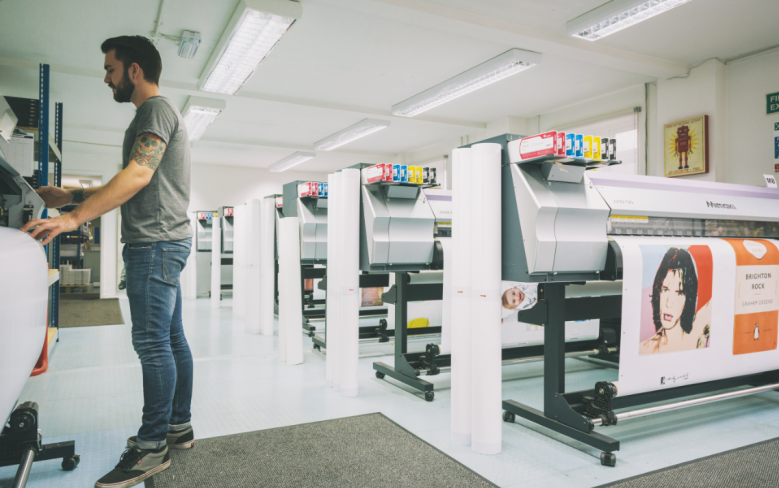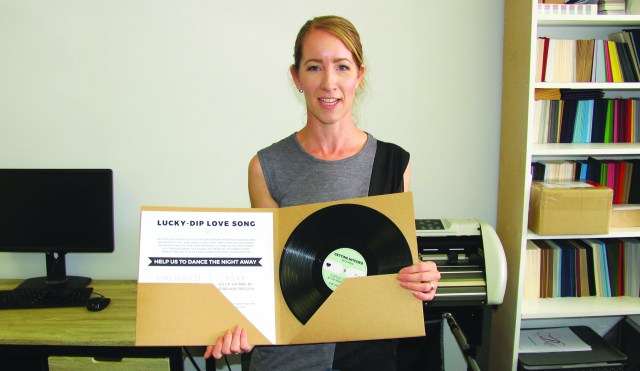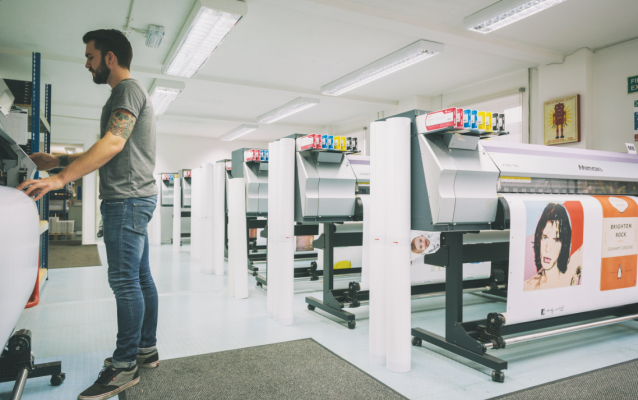
Digital print is no longer the poor man’s print, with ever shortening deadlines for work, and increasingly tight turnarounds making digital investment necessary for almost every print operation in some shape or form.
Making the right investment is about first identifying where you want your business to go—is high-value finishing work your forte, or do you want to offer an on-demand W2P service? Do you see yourself as a specialist, and want to refine that, or are you trying to offer as many different services to your client as possible?
In its 2018 census results, association conglomerate FESPA notes, “Print businesses continue to respond to sustained customer demand for fast turnaround, short runs and JIT delivery with strategic digital technology investments.
“Cost reduction and diversification into new markets and product offerings remains a focus of investment for 53 per cent of those surveyed.”
Within the sign and display market, FESPA's main focus, it seems that digital investment is needed to both reduce the costs of short run work, along with opening up new revenue streams.
Commercial printers are also increasingly supplementing offset production with new digital systems, which allow for higher-margin work.
While the phrase ‘offset quality’ is often thrown around casually in the digital print realm, the latest generation of presses, finishing equipment, and inkjet/toner heads have a much greater claim to quality than the systems of just five years ago.
Resolutions of 1200dpi, as small as two-picolitre size ink drops, single pass inkjet, inline finishing, and variable data print are the new reality.
Significantly, there have been leaps and bounds made in automating the print process, moving towards a business model with minimal operator intervention. For big software/hardware giants like EFI, the end goal is a system where jobs come in, are automatically checked for quality issues, sent to the printer, and can be out the door without an employee needing to do anything at all.
The digital print systems are increasingly flexible with substrates too, opening up new applications for printers. The Screen 520HD+, newly launched at Hunkeler Innovationdays, can handle uncoated offset stocks, at what it calls offset speeds, but with each print in the run a unique piece, thanks to variable data print. The company claims that it has successfully printed on gloss, silk, and matt offset coated stocks without priming.
Konica Minolta’s ‘offset replacement’ is its signature AccurioJet KM-1. It is essentially a Komori chassis with feed, paper transport and delivery from the Japanese offset giant, with the inkjet printing technology from Konica Minolta. It prints on offset stocks at 1200x1200dpi in single sided or perfecting mode at 2700sph. There are no plates, no makeready, and it can print variable data.
At its initial launch at PacPrint 2017, Mark Brown, product marketing manager, Konica Minolta, contended, “Make no mistake the AccurioJet KM-1 will be an offset replacement machine. Run lengths are coming down all the time, most work is now short run, and most work is wanted virtually immediately, the KM-1 delivers on all these points. No plates and no makeready makes life easy for printers.”
For Fuji Xerox, the Iridesse represents the latest in digital print for commercial applications and beyond. The Iridesse is able to to print specialty colours including metallic with a single pass, by housing up to two additional specialty dry inks of gold, silver, clear and white, in addition to CMYK. It is offering speeds of 120ppm with substrates up to 400gsm, with print resolution of 2,400dpi, and a few early adopters in the Australian market, including Theo Pettaras’ of Digitalpress, and Ian Bosler of Intertype.
Over at Fujifilm, the new-to-market third generation B2 inkjet press, the Jet Press 750S is capable of 3,600 B2 sheets per hour, can be equipped with food-safe inks, and capable of handling coated and uncoated offset stocks.
The previous model, the Jet Press 720S was among the first B2 inkjet presses to gain a foothold in the market, with over 150 Jet Press installations worldwide.
With the continued, steady increase in demand for short run work, Fujifilm says the introduction of the Jet Press 750S means that more and more jobs are going to fit the sweet spot, for print runs up to 5,000, depending on ink coverage.
A spokesperson from the company says, “The target for this press is not the toner-dominated, on demand market where runs of ones and twos predominate. The Jet Press 750S will compete with, and out-perform, offset presses in the production of high quality, short run print jobs. This makes it an ideal investment for a much larger range of commercial and packaging printers.
“Like the Jet Press 720S, the new press is the perfect blend of old and new technologies. Built on an offset chassis, it features superb sheet-to-sheet, front and back registration and up-time on a par with offset, combined with the very latest industry-leading Samba inkjet printheads, to deliver print quality that outperforms offset.”
There is no discussion of digital print without the HP Indigo, the clear-market leader in the B2 digital space. Supplied by Currie Group in Australia, the latest in the series, the HP Indigo 12000 Digital Press is quoted by HP as delivering 1625 dpi, or a virtual resolution of 4876 x 4876 dpi, with a printing speed of up to 4,600 B2 colour sheets per hour, maximum sheet size of 75cm x 53cm, and applications supporting synthetics, canvas, or metallised with the on-press HP Indigo ElectroInk Primer.
For printers looking to dip their toe into Indigo, Currie Group has recently starting selling affordable, entry-level refurbished presses under the HP Indigo 7r badge, based on the HP Indigo 7000. Remanufactured on a dedicated production line, they undergo the same integration process and testing as new presses, and can be reconfigured in up to six colours, including white ink, fluro colours, and an option for a heavy substrate kit.
Automating efficiency
Digital makes life easier for printers. Automating quality control, removing sheets with errors, having the finishing inline, along with dual printer/cutters, frees up PSPs to spend more time selling, upselling, and strategically planning the future of their business.
Konica Minolta’s IQ-501 Intelligent Quality Optimiser continuously monitors, controls and adjusts printed colour, density and registration by reading each printed sheet with a Konica Minolta developed hybrid scanner system.
It is now offered within the company’s latest devices, with the company quoting time savings of 40 per cent in operator setups.
Over at Ricoh, the new Pro C7200 and C9200 Graphic Arts Edition offer inline finishing onboard, through a partnership with Plockmatic. For a print service provider in the book printing space, the C9200 can produce a 50-sheet, 400-page book in A4 at 135ppm, saddlestitched with a square spine, fully trimmed.
Then there are finishing options: a staple finisher, a booklet maker and trimmer unit, a multi-folding unit that supports six fold patterns, a high capacity interposer, a GBC StreamPunch, inline ring and perfect binding systems as well as twin high-capacity stackers.
Emotions Wedding Photography, a new business chaired by industry icon Michael Warshall, who made his name in photographic repro through Nulab, is using a C9200 for its fast-turnaround next-day photography service for weddings and events.
Single-pass inkjet in corrugated
Digital is next set to shake up the packaging and corrugated board market, with multiple single-pass inkjet presses set to hit the market and compete with the EFI Nozomi, including a new joint venture by KBA and Durst.
The press created under the joint venture, VariJet, will use water-based inks, and be developed in Germany by both companies.
It is set to debut at drupa 2020, while the ink and service business around the press will be handled by KBA and Durst respectively under the agreement.
Operating in the same space is the Sun Automation single pass aqueous press, disrupting packaging sheetfed with digital print at 1.6m x 3m wide, printing at 70 metres per minute, and The HP C500 single pass aqueous press, 1.32m x 2.5m with a print speed of 75 metres per minute print.
The Nozomi, after a little over a year on the market, now has a white ink option, with Australian company Orora the first worldwide to trial it.
Attendees of the Auspack show were able to see the quality of print it produces, and the design options that open up for corrugated packaging when white ink is a possibility.
Comment below to have your say on this story.
If you have a news story or tip-off, get in touch at editorial@sprinter.com.au.
Sign up to the Sprinter newsletter


